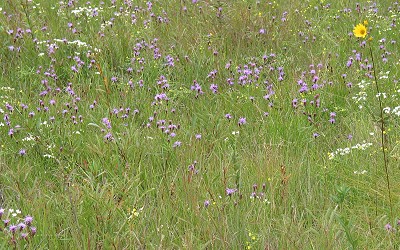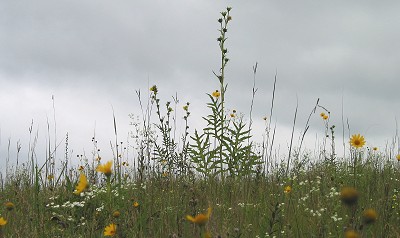I’ve been trying to digest all the things I heard at the prairie conference, and I’ve decided I should write some of them down so they could possibly be useful.
Some of the prairies I saw on the field trips had lots of Canada Goldenrod, and some didn’t. Mostly people didn’t talk about Goldenrod – one comment I heard was that mowing a lot does help – but otherwise no one seemed too concernced about it.
One talk I heard was about the problem of densely planted prairies dominated by Big Bluestem. The researchers were interested in finding out if they could improve the diversity in the prairie by mowing, and then overseeding with forbs. It worked quite well.
In prairie plantings, more dense planting of seeds didn’t seem to make much difference – so I think that our planting of about 6 pounds per acre should be fine.
Shawn Schottler did a project that indicated that planting more forbs was helpful in reducing weeds – more grasses didn’t help. The advice I always got before was that it was good to plant more grasses – now I think I’ll start planting more forbs. Shawn suggested planting more of the 3 cheap ones – Monarda, Yellow Coneflower, and Black-eyed Susan – to keep the cost of seeds down.
One field trips I went on was to Tom and Kathy Brock’s savanna restoration west of Madison. It’s a wonderful restoration – very inspiring – they’ve removed most of the brush so the structure of the savanna has come back. They’ve planted local seeds under the oaks, and burned every year, and now the understory is coming back too. They have a web site that details all the work they’ve done, and the progress they’re making.
Another of the stops on the field trip was to a State Natural Area near the Brock’s place, which they also help to restore. It’s a hill that sticks up from the floor of the valley, and it’s covered with dense prairie vegetation – mostly forbs – a really spectacular place. It’s called Black Earth (Rettenmund) Prairie SNA.
Here are a couple photos –
a view of the top

a patch of Cylindrical Blazing Star

and the horizon with a Compass Plant

We saw one other place, which was also spectacular – with a restored area where Pale Purple Coneflowers had come back after it was cleared and burned, and an amazingly diverse and beautiful planted prairie. The folks who did that planting think that prairie grasses are slow to get going – that is part of the succession of the prairie – so you shouldn’t plant too much grass or it will take over. They planted only 1 pound of grass seed per acre.
Here’s a photo of part of that 4 year old planted prairie:

